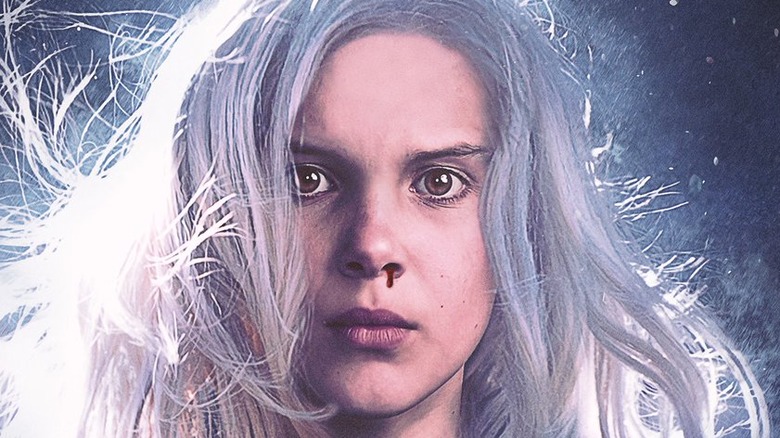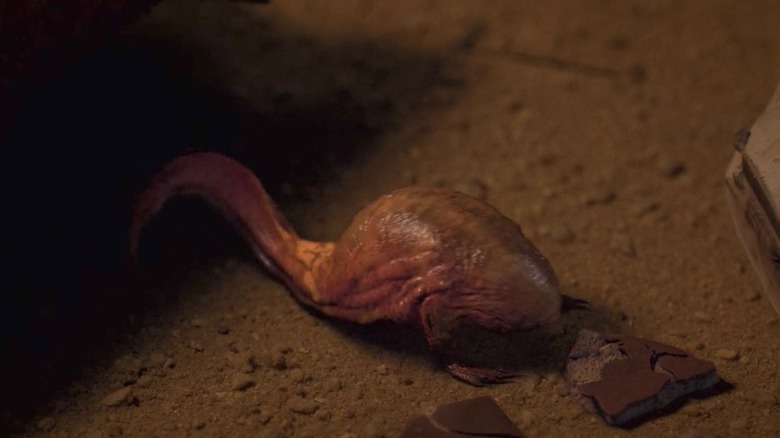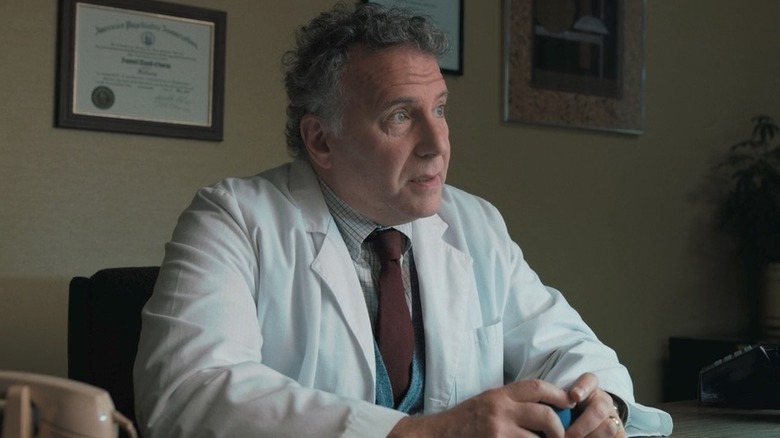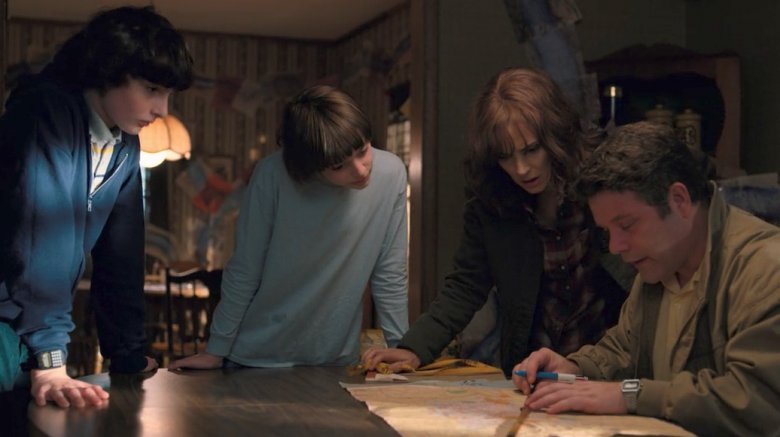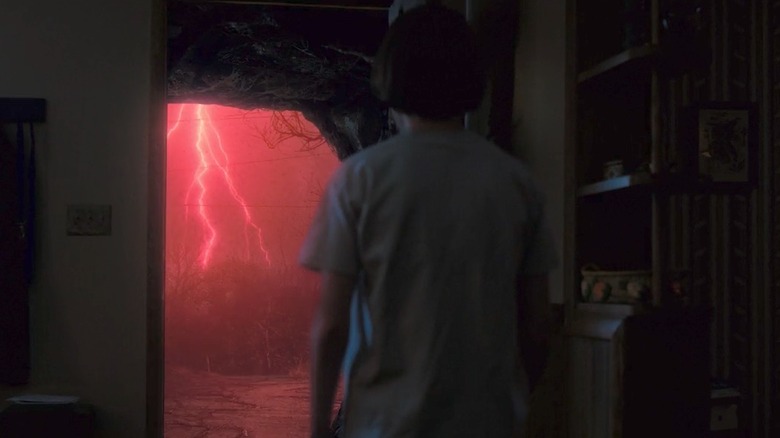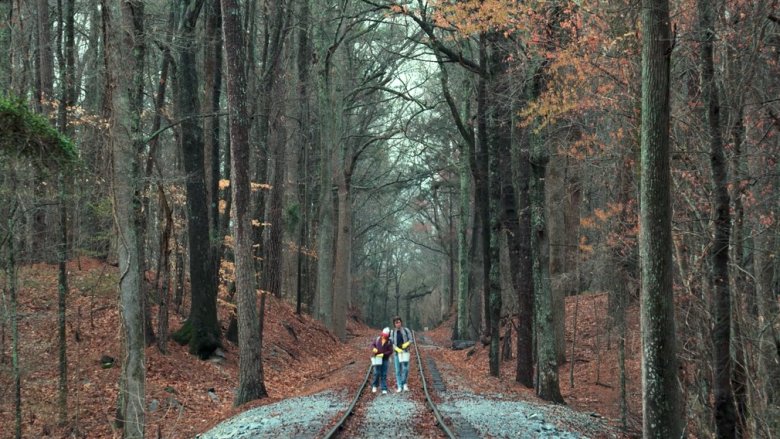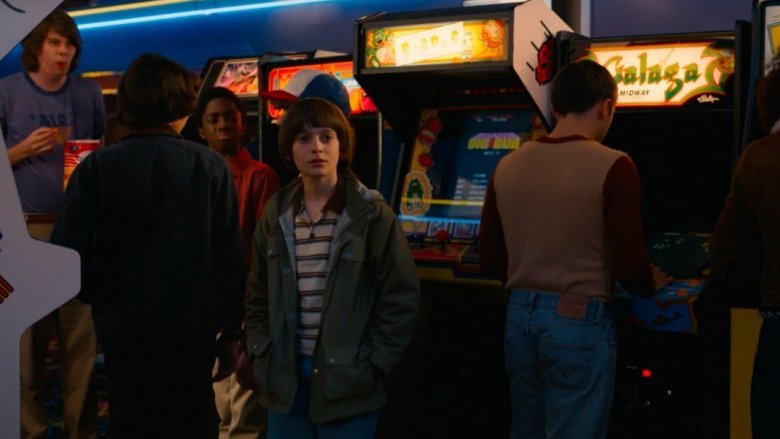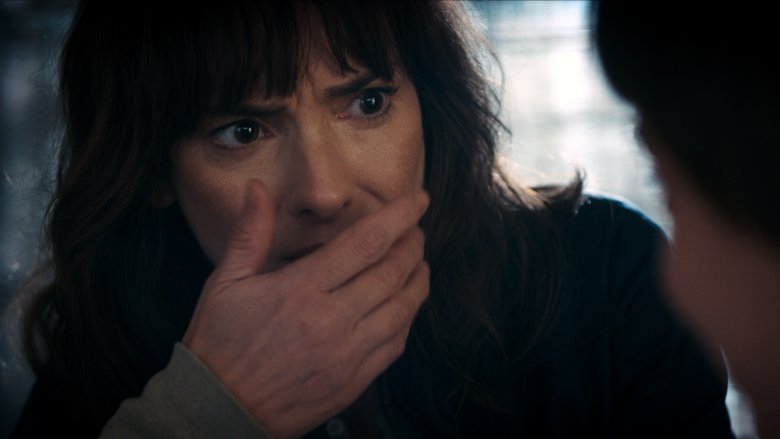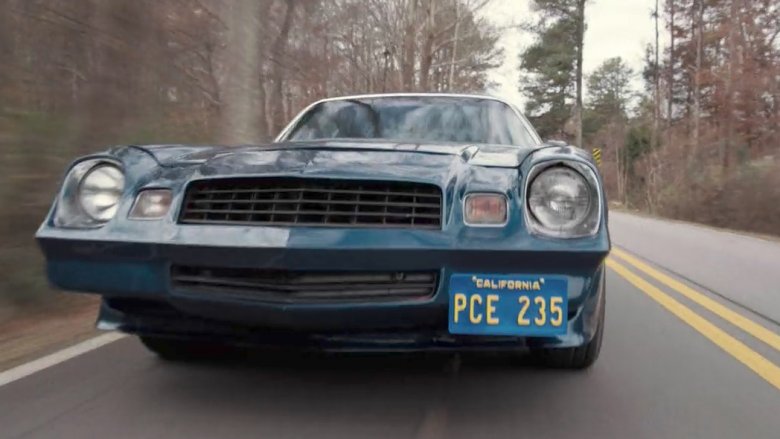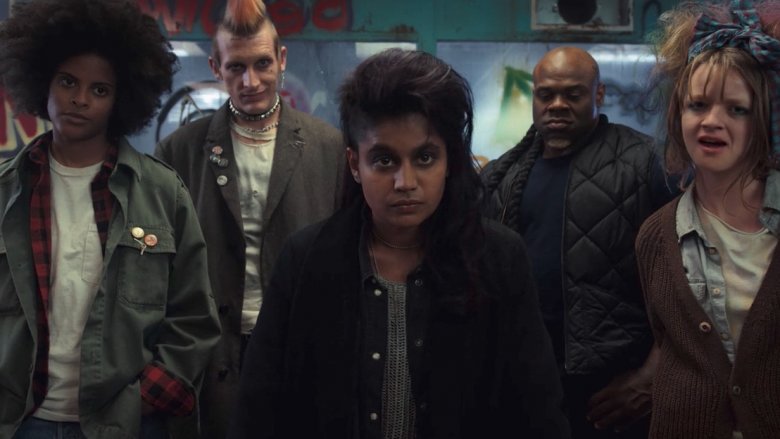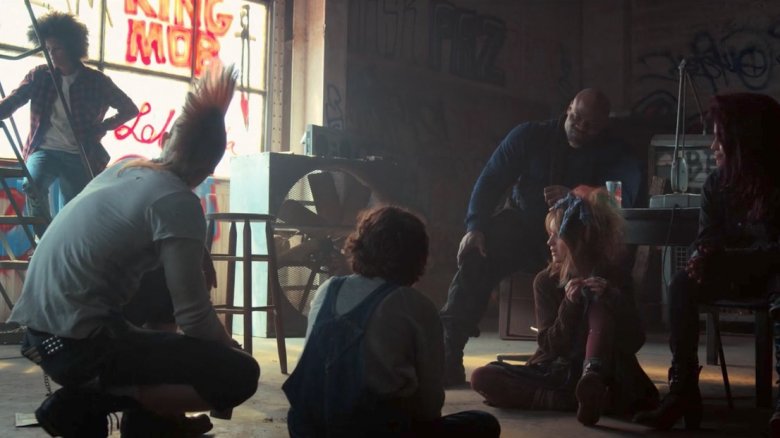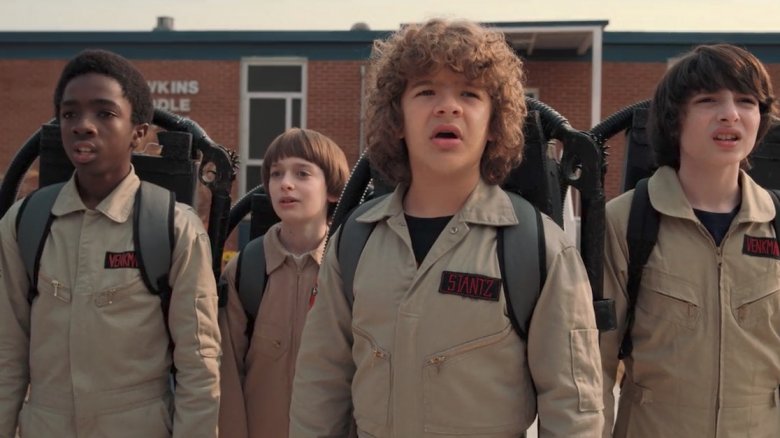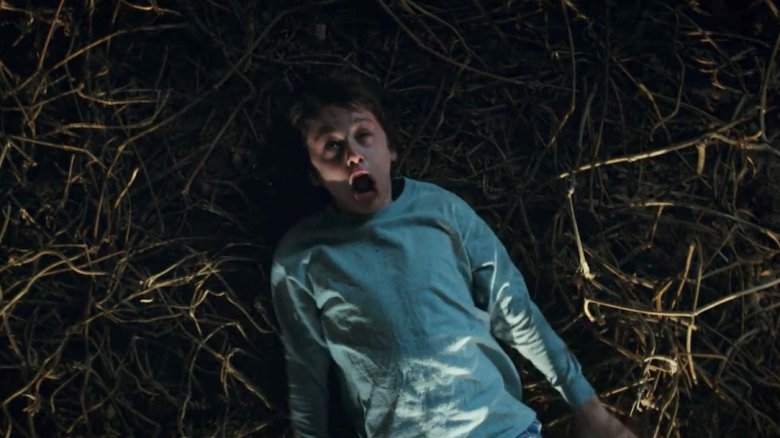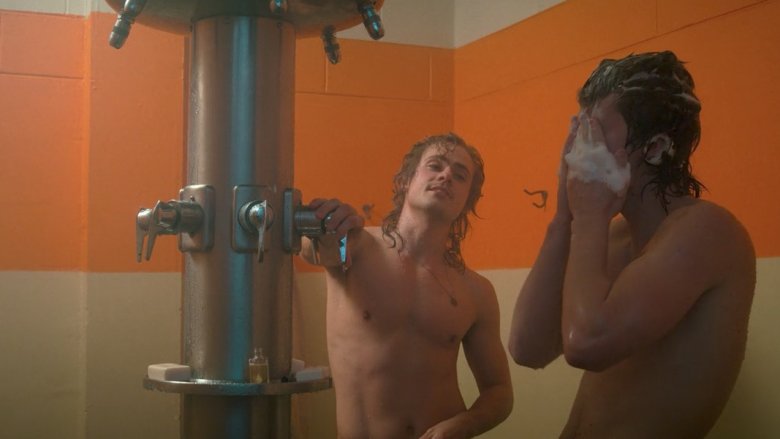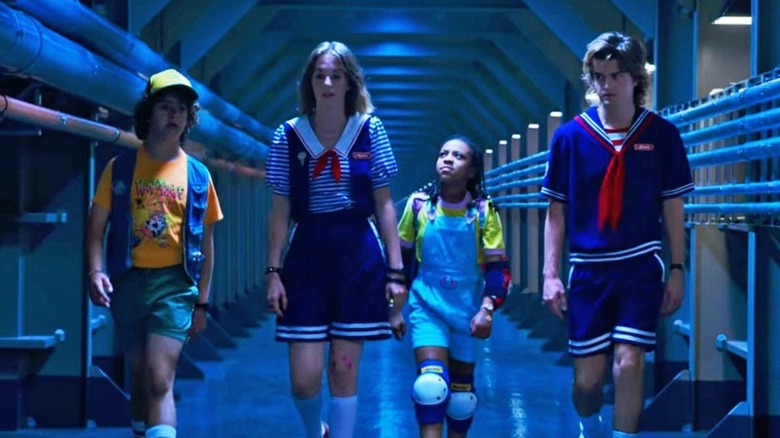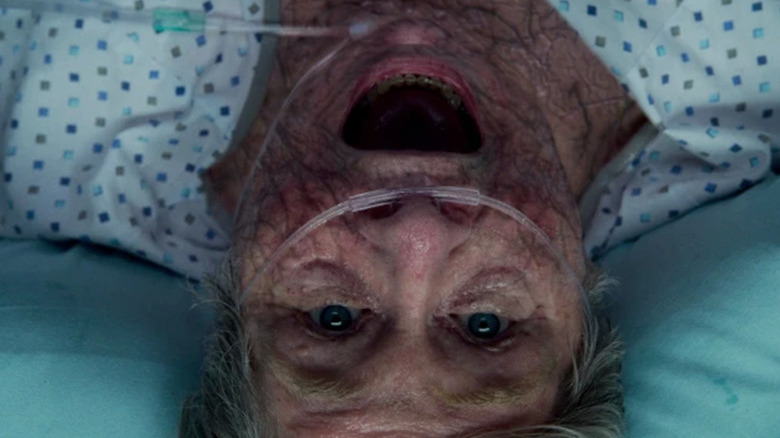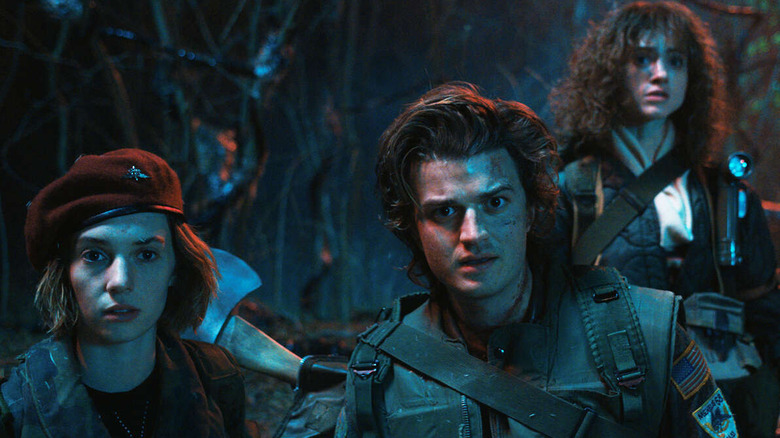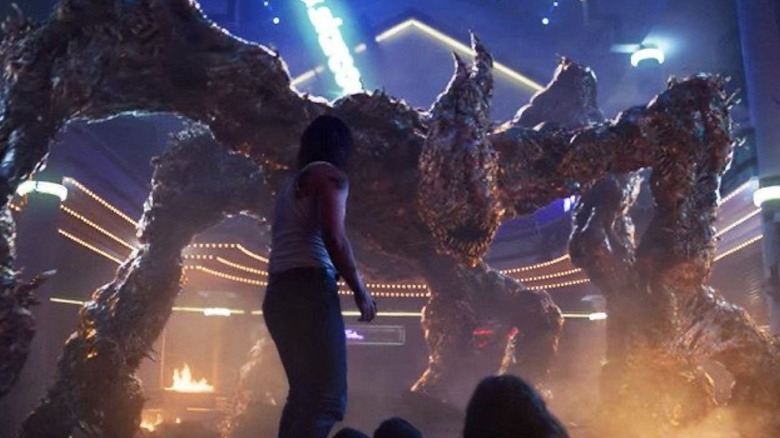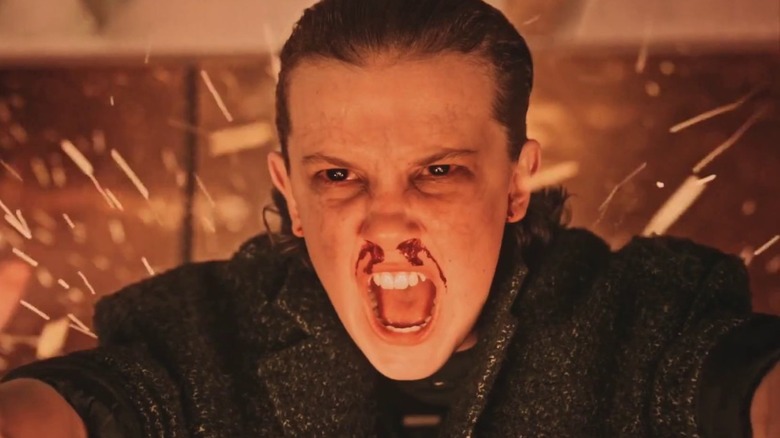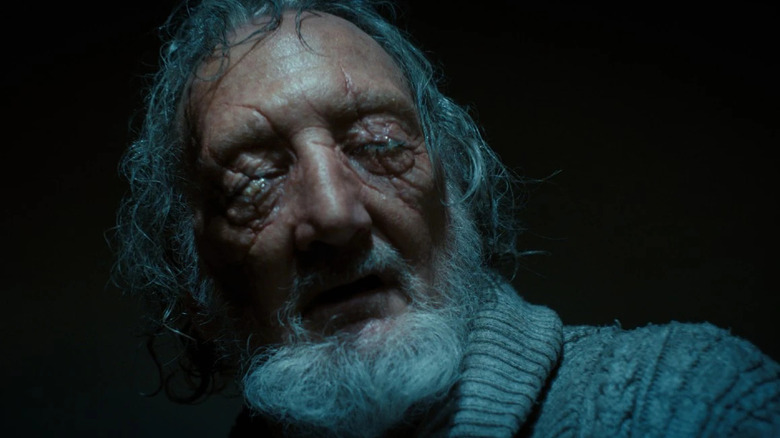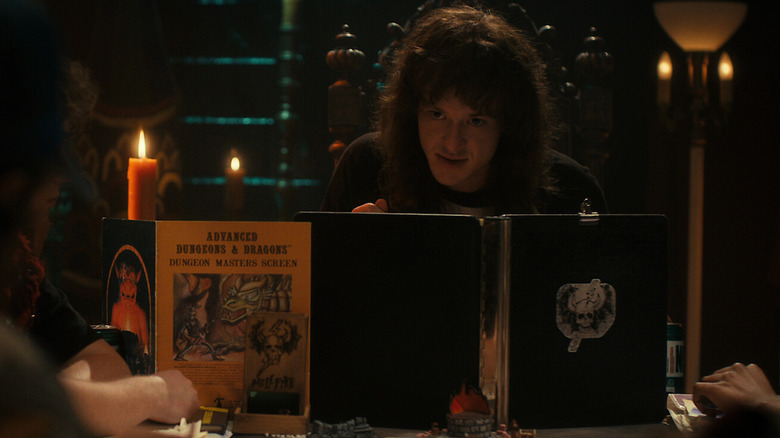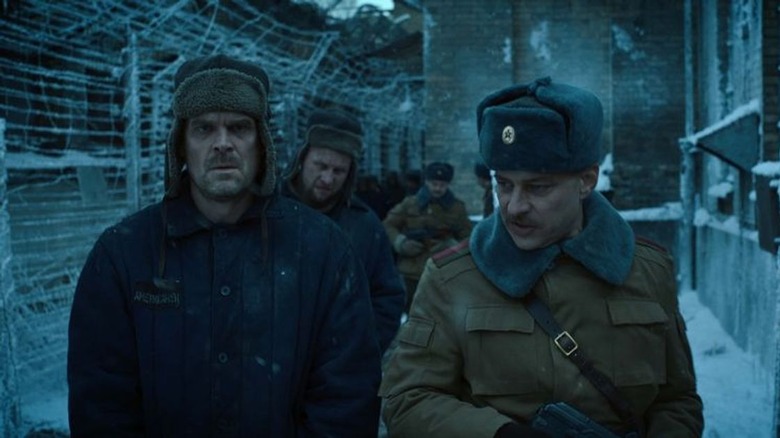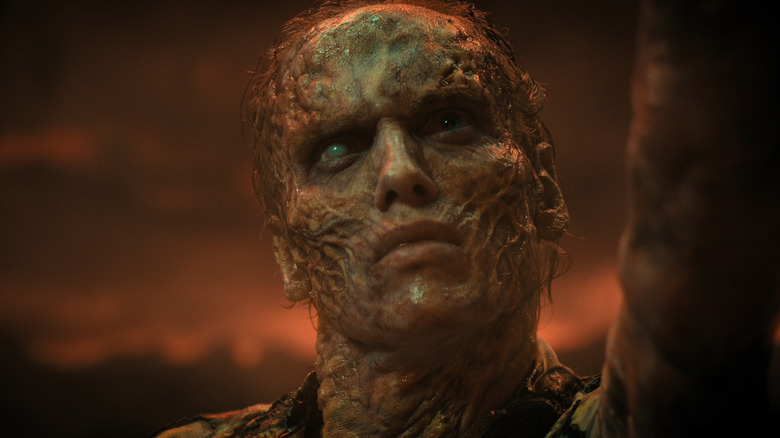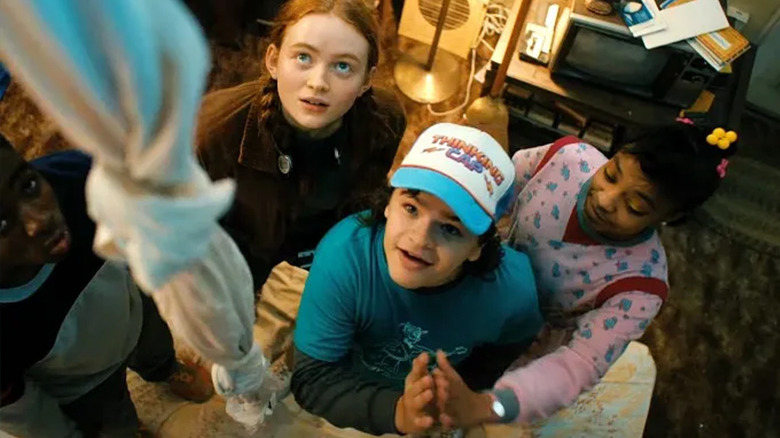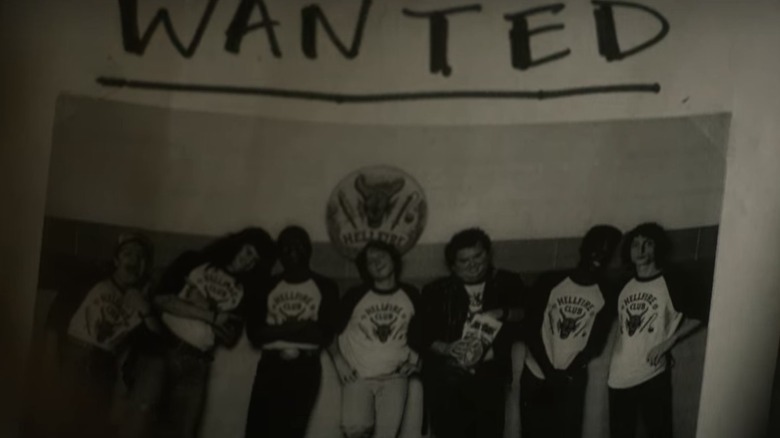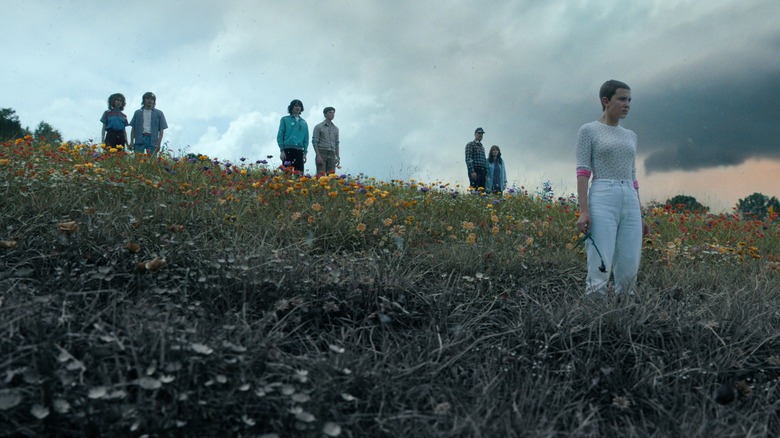References In Stranger Things Only True Fans Understood
"Stranger Things" has been a hodgepodge of cultural references since the very first episode, and the show has only continued to supply fans with Easter eggs and winks to various bits of pop culture throughout its run as a Netflix Original hit series. The Duffer Brothers' love of sci-fi and horror classics shines through in every single episode of the show, and fans who pay close attention are bound to notice movie references galore.
To celebrate the show's successful pop culture pastiche style, here's a list of references that only true "Stranger Things" fans will get. Spoilers ahead!
Gremlins
Dustin is a fan favorite for his constant optimism and relentless affection for his friends, but fans of the classic movie "Gremlins" had even more reason to love him — his raising of a pupal Demodog that he nicknamed D'artagnan. Dart's hatred of the heat lamp is a pretty direct parallel to "good" gremlin Gizmo's light sensitivity. And when Dart eats Dustin's cat (which has to be an "Alf" reference), it's only after Dustin feeds him — and then finds him in the boy's bathroom next to an open toilet stall. (You know that thing about getting gremlins wet and feeding them, right?)
Thankfully, Dustin's faith in his monstrous pal is rewarded when his former pet lets him and his friends pass — a lot like how Gizmo is the only good Mogwai of his species. Still, just to make sure that attentive fans hadn't missed the direct parallels to the movie, when Dart first escapes into the school, a musical sting plays that's almost note-for-note the main "Gremlins" theme.
Aliens
There are a ton of '80s movie influences in "Stranger Things 2," but "Aliens" is the film that really connects the strongest.
We'll start with Paul Reiser as Dr. Owens, delivering a performance in which nearly every moment is a reference, callback, or direct subversion of his role in "Aliens" (and one moment referencing "Diner"). Like Burke in "Aliens," Owens seems perpetually sketchy, constantly avoiding the responsibility for his own actions, while positioning himself as the only sane voice in a sea of madness. He even watches a crew of heavily armed mercenaries on camera as they invade a labyrinthine series of corridors in order to fight multiple versions of the creatures that appeared in the original — exactly like Burke in "Aliens."
Speaking of "Aliens, do we even need to mention the visual similarity of Eleven's curly black hair in Season 2? Ripley's not the only black-haired protagonist battling monsters like the one that almost killed her before, and who nonetheless descends an industrial elevator prepared to battle a massive mother creature that's trying to kill the only people she loves.
The Goonies
Since we're talking about blatant hints at famous actors' past roles, we'd be remiss not to mention Sean Astin as Bob Newby, Joyce's new beau in Season 2. While he's sometimes recognized as Samwise in "The Lord of the Rings," kids of the '80s will recognize Astin as Mikey Walsh, the optimistic, treasure-hunting leader of "The Goonies" — a movie that's ingrained into the DNA of "Stranger Things." Astin even gets a particularly memorable line when he asks if the X at the center of Will's root maze is "pirate treasure" like the type that Mikey once hunted.
We also get another sweet reference in Steve Harrington's journey into the tunnels with the kids (minus Will) as he wears a red bandana. Steve, like Mikey's big brother in "The Goonies," is a jock with a heart of gold — and a penchant for red bandanas and doling out life advice to his younger charges.
Steven Spielberg
To say the Duffer Brothers are indebted to Steven Spielberg is putting it lightly — there's a metric ton of Spielberg references in both seasons of the show, but especially "Jurassic Park" during "The Mind Flayer," in which Joyce, Will, Mike, Hopper, and Bob try to escape the facility. The Demodogs almost move like Velociraptors, and Bob's quest to reboot the system without getting eaten has some painful familiarity for Samuel L. Jackson's character Ray Arnold in "Jurassic Park." Plus, Steve's solo faceoff against a Demidog in an earlier episode, only to be immediately surprised by another one to his side, is as blatant a "Clever girl" reference as you can get.
To jump from dinosaurs to aliens (lower-case "a" this time), there's another direct swipe of a classic Spielberg movie as Will steps outside the Arcade to look directly at the Mind Flayer in the Upside Down, a direct reference to a famous shot from "Close Encounters of the Third Kind." Oh, and one more: "Poltergeist" (although technically directed by Tobe Hooper with input by Steven Spielberg) has a few more references in the new season. Eleven enters the Upside Down by listening to static on the television — a nod to poor Carol Anne — while Joyce presses her face up against the TV while trying to figure out what happened to her son on Halloween.
Stephen King
Let's jump from Steven Spielberg to Stephen King as we talk about the Duffer Brothers' other biggest influence. The King references run rampant throughout the second season: Bob talks about living in Maine, terrified of a clown that haunted his dreams a la "It," while Steve's "Goonies"-esque expedition into the tunnels (kind of like sewers in a way, hm?) takes a lot of visual inspiration from King's terrifying novel.
Meanwhile, Eleven has a lot in common with both Carrie in "Carrie" and Charlie in "Firestarter." Like Carrie, she's dealing with puberty, crushes, and telekinetic powers. Like Charlie, Eleven is holed up in a cabin with her father figure as they attempt to evade the nefarious government operatives looking for them. Even Eleven's final battle against the Mind Flayer is visually laced with the "Firestarter" movie, with rich reds flowing behind her as she unleashes her powers.
Finally, if we're going to talk about small towns beset by bizarre permutations of mist that hide dinosaur-like creatures whose origin is shrouded in mystery... well, it's hard to know if we're talking about "Stranger Things 2" or King's twice-adapted story "The Mist." Last but not least, it's impossible not to watch Steven and Dustin traipse down a railroad tracks in "The Spy" talking about girls, life, and feelings without hearing Ben E. King's classic song, used to such memorable effect in the Stephen King-inspired movie "Stand By Me."
Video Games
Video games play a big role in the lives of the "Stranger Things" kids, but the games they play have an even bigger impact on the story at large. For example, in Episode 1, Dustin and Lucas play "Dragon's Lair," but Dustin can't beat Lucas' high score. The scene ends with Lucas telling Dustin, "You'll get there someday. But until then, Princess Daphne is still mine." Lucas and Dustin eventually end up competing over the affections of new girl Max — who eventually ends up with Lucas, not Dustin, mirroring the video game competition.
Another of the kids' favorites is "Dig Dug," a classic game about a player navigating strange, unexplained tunnels as he's menaced by mysterious monsters. Hopper definitely seems like the "Dig Dug" man when he goes in to investigate the Mind Flayer's root tunnels, but the parallels don't stop there. Hopper actually fails to clear out the hub in the tunnels, and has to be rescued by Joyce, Will, and Bob. It's only when Steve and the kids venture into the tunnels that they're able to complete the mission. Attentive viewers wouldn't have been surprised, though... That's the group that includes Max, the current high score record holder of "Dig Dug."
Steven Spielberg, part two
We're back to Spielberg, but we can't keep talking about "Stranger Things 2" without mentioning one of the director's most famous sequels, "Indiana Jones and the Temple of Doom." Nancy drives a hot poker into Will's side to drive out the possession (we'll get to that next) of the Mind Flayer, an exact reference to Short Round doing the same thing to free Indy from a murderous rage. Not only that, the scene of Max driving the car to the pumpkin patch while wearing wooden blocks on her feet is a direct reference to Short Round driving, at least according to the Duffers. Oh, and we almost forgot Hopper going back for his hat after being attacked by vines in the Mind Flayer tunnels.
While we're on the subject of Season 1, we'd be remiss if we skipped over some of the references to "E.T. The Extra Terrestrial," a guiding light for the first season. Eleven offers to dress up as a ghost, just as E.T. did to go out on Halloween, while Will's favorite candy just so happens to match Spielberg's favorite wrinkly alien's tastes.
Mad Max
Like the boys in Season 1 of "Stranger Things," Max's personality is shaped by the pop culture she enjoys, but it also reflects her own character. Her name on the arcade high scores say MADMAX, which is an obvious reference to George Miller's series of films. The arcade manager even nicknames her "Road Warrior," which is the sequel to "Mad Max," a film so named for a character in a sequel herself. The parallels get more blatant from there — notice how often she's in a speeding car racing down the road as it's driven by a giggling sociopath?
One more for good measure: Max, Lucas, Dustin, and Steve build a tricked out school bus out of junkyard materials, which is a pretty Mad Max thing to do. And, hey, is Steve pouring "Guzz-oline" on the meat to trap the Demidogs?
The Invisibles
The 7th episode of "Stranger Things 2," "The Lost Sister," proved contentious, with some fans loving the side story as Eleven reunites with her psychic sister and others feeling it was a frustrating detour. Love it or hate it, the episode was almost a direct adaptation of the classic cult comic "The Invisibles," penned by writer Grant Morrison and drawn by Steve Yeowell and Jill Thompson (among others).
"The Invisibles" follows a group of castoffs fighting against a shadowy conspiracy that might be the government or the world's oligarchy or bug aliens from space (it's a fairly dense text). Kali's group matches the Invisibles in ideology as she tells Eleven about who they are and where they come from, but that's not all; in the comic, each character is given a codename, a pattern that's mirrored in Kali's group. In "Stranger Things," there's Kali, Funshine, Axel, Dottie and Mick, all of whom bear at least a passing resemblance to the designs and characters of the comic, with Dottie almost a direct visual adaptation of Ragged Robin.
Eleven's nickname subverts expectations, as Kali is one of the few characters to call her by her birth name — for all intents and purposes, "Jane" is the codename for Eleven, since that's how the audience and the other main characters know her.
The Invisibles part two
By the way, for anyone thinking it's a stretch to connect "The Invisibles" with "Stranger Things," take a look at the graffiti in the above picture. King Mob is the leader of "The Invisibles," while O'Bedlam is a homeless shaman that affects events behind the scenes, and teaches a wayward youth the true meaning of family and how to harness their inner power. Kali ends up a little bit O'Bedlam and a little bit Yoda in "The Empire Strikes Back" when she teaches Eleven to harness her powers.
"The Lost Sister" has more in common with "The Invisibles" than codenames and visual references, however — the overall goals of Kali's group line up perfectly with the Invisibles. Both are punk outcasts fighting against the Man (in "Stranger Things," this is perfectly epitomized by a suspicious cop with a note-perfect '70s mustache, along with all those pesky government spooks) by committing crimes and using mind-bending psychic powers. More than that, Eleven's entrance into the group mirrors the POV character from the first volume of "The Invisibles," Jack Frost. Both are struggling against the expectations of their parent figures, thrust into a confusing war, and leave the group confused and seemingly distant. Still, in the comics, Jack Frost eventually comes back, so if the parallels continue, we should expect to see Kali and her punk warriors in future seasons.
Ghostbusters
"Ghostbusters" is another sci-fi favorite of the era that's central to the plot of Season 2, as the boys dress like their favorite characters (even if they end up arguing about having two Venkmans) for Halloween. The movie has also got a larger influence on the show because, like in "Ghostbusters," an otherworldly evil has invaded their town and even possesses one of the characters to help open a mysterious gate in order to force itself into our world. Plus, Dustin even mirrors his heroes by capturing a gluttonous beast (D'artagnan) with a replica "Ghostbusters" trap.
Vintage horror
While "Stranger Things" has always dabbled in horror tropes, Season 2 had a haunted truckful. For starters, Will's horrific possession by the Mind Flayer ends with a ear-splitting shriek straight out of "Invasion of the Body Snatchers." Even while Will's possessed, the horror doesn't stop with blatant references to "The Exorcist" as Joyce tries to rid her son of the otherworldly sickness. It even involves a black-veined child grabbing someone by the throat, which has become as inextricable from possession movies as black contact lenses and garbled Latin. There's also a more subtle reference to "The Thing" when Will first wakes up after being possessed by the Mind Flayer — the camera lingers in front of and behind him like he's an object impersonating a person, rather than the character we've grown to love. Though the show's other reference to "The Thing" was one of the details "Stranger Things" got wrong about the '80s, this scene was still a striking moment.
On the slasher side of things, there is a "Nightmare on Elm Street" reference when Eleven first pierces her way through the stretchy elastic barrier between the real and the dream-like reality of the Upside Down — although the familiar scene is subverted when it's Eleven that bursts through, rather than the burned visage of Freddy. In "Trick or Treat, Freak," Max even jumps out at the boys while wearing a Michael Myers mask from "Halloween," a movie about a babysitter stalked by a remorseless killer — Steve should be so lucky as to fight one human killer rather than a pack of Demodogs.
'80s references
One of the central appeals of "Stranger Things" is that the characters are as shaped by their love of pop culture as the audience. By flipping through the channels of her beloved television, Eleven has all sorts of reflections of her life, but likely none that resonate as strongly as the "Punky Brewster" episode that flashes briefly by in "The Lost Sister" as Punky, a little girl adopted by a gruff older man, is scared of seeing the doctor. It's really no surprise that it's the episode that pushes Eleven back towards her own gruff adopted father, Hopper.
While we haven't really discussed Max's sociopathic brother Billy much so far, there's plenty to dig into, reference-wise. There's his heavy "Top Gun"-esque homoerotic rivalry with Steve (including his penchant for open shirts and oiled chests), his "St. Elmo's Fire"-inspired wardrobe (even using the same name as Rob Lowe's character Billy), but the deepest cut is probably his connection to Joel Schumacher's cult classic "The Lost Boys." The movie's focus on California, dangerous driving, and very sexually-charged rivalries makes it an easy fit for Billy, but the show's subversion of "The Lost Boys" sweeter sibling dynamic makes it more purposeful. Try and watch Kiefer Sutherland vamping it up in Santa Carla and then watch Dacre Montgomery's flirtatious fight with Steve and not pick up a thematic connection.
Dawn and Day of the Dead
In Season 3's first episode, the Hawkins crew has Steve sneak them into the movies for free. The movie in question is shown to be 1985's "Day of the Dead," the third film in George A. Romero's legendary zombie series. As opposed to its predecessor, 1978's "Dawn of the Dead," the third film's survivors operate within an abandoned underground bunker. This stands in contrast to the second film's location: an abandoned but still functional shopping mall.
Beyond being just a fun visual addition, the choice of the film actually relates back to the season's eventual plotline. For starters, the citizens of Hawkins get taken over by the Mind Flayer and become similar to zombies in their behaviors. Additionally, there is the matter of the Russian base that Dustin, Robin, Steve, and Erica infiltrate partway through the season. With this setting being attached to the Starcourt Mall, it's hard not to see the parallels to both of Romero's films.
Invasion of the Body Snatchers
Season 3's main threat first manifests in the return of the Mind Flayer, the antagonist from Season 2. Part of its sinister machinations manifests in widespread mind control over a wide array of Hawkins citizens. Anyone under its influence seems to maintain certain basic traits of their normal state but is definitely under some otherworldly influence. If this plot element seems at all familiar, that's because it's right out of "Invasion of the Body Snatchers," which has already been referenced in the series but gets even more direct nodding in Season 3.
The classic '50s science fiction horror film (an adaptation that was remade in 1978) was centered around the invasion of what are now referred to as pod people. These pod people emerge from plant-like seed pods and assimilate all the traits of a real person, sans their emotions. "Stranger Things" has always had a knack for paying tribute to celebrated genre classics, and this was no exception. It's a grand tribute to a horror classic that also plays perfectly into the season's widespread threat.
Cold War-inspired cinema
Given its setting in the 1980s, "Stranger Things" has seen fit to reference social issues relevant to the decade. Season 3 most definitely capitalizes on the Cold War conflict of the 1980s. At the beginning of the season. Dustin, trying to contact his summer camp girlfriend Suzie, intercepts a Russian transmission. This eventually leads to him and Steve, with Robin and Lucas' sister Erica in tow, making a discovery: the presence of Russian soldiers and scientists running a secret lab underneath the newly-built Starcourt Mall.
Of course, a ragtag group of youths dealing with a Russian threat is right out of the 1984 action film "Red Dawn." One other reference to Cold War-era cinema arrived most recently in Season 4 through the character of Erica, who wears a U.S. Flag as a cape. This definitely evokes shades of "Rocky IV," the goofiest entry of the "Rocky" series which sees Rocky fight the Soviet Union's Ivan Drago. At the conclusion of that film, Rocky is adorned with an American flag following his victory (as if his red, white, and blue trunks weren't enough). These cute little nods only serve to further intensify the flavor of the pop culture reference milkshake that serves as the lifeblood of "Stranger Things."
John Carpenter's The Thing
The filmography of John Carpenter has most definitely received some love from the Duffer Brothers in "Stranger Things." From the series' synth-heavy soundtrack to some neat visual Easter eggs, Carpenter's filmography has always been an influence. A minor example of this is Max's Halloween costume as Michael Myers. However, Season 3 sees these homages take center stage, especially through the season's returning threat of the Mind Flayer.
During the season's bombastic conclusion, the Mind Flayer finally emerges via a repulsive physical form composed of flesh and tentacles. This creature's disgusting final appearance is visually in line with the final form of the entity from Carpenter's "The Thing." Additionally, the pod people-inspired assimilation of various Hawkins residents is also in line with "The Thing" as well. This is due to the Thing being able to assimilate its victims, thus being able to blend in with the group to avoid detection — yet another example of the Duffer Brothers utilizing a celebrated horror staple to enhance their ever-expanding fictional universe.
X-Men
"Stranger Things," given its episodic nature, has always shared similarities with the vast world of comic book media. From its cliffhanger endings to the evil otherworldly entities it uses as villains, all the show is missing is a big splash page. One comic series that the show has many overlapping elements with is X-Men, especially through Eleven's superpowers. Eleven's abilities — telekinesis, entering people's minds, and even levitation — have always evoked shades of Jean Grey.
Jean was first introduced in the inaugural issue of "The X-Men" back in 1963, a far cry from the character she'd eventually grow into. Her most noteworthy storyline is the "Dark Phoenix Saga," concerning a destructive cosmic entity that Jean shares a connection with and is often taken over by. The "Dark Phoenix Saga" is also where the recurring threat of the Hellfire Club makes its debut. This is the exact same name used by the "Dungeons & Dragons" club led by Eddie Munson in Season 4. There is also the way that Eleven is able to ping pong through different people's heads, much like Charles Xavier and his Cerebro machine.
A Nightmare on Elm Street
Undoubtedly one of the core references used for the story of Season 4 is Wes Craven's "A Nightmare on Elm Street." These references manifest in the form of the show's newest baddie: the sinister and sadistic Vecna. From his first moments on screen, Vecna is most definitely a force to be reckoned with — far different than the threats before him. For one thing, Vecna has a voice and a defined personality that sets him apart from the preceding voiceless monstrous entities. His appearance, charred and mutated with long claws, as well as his ability to prey on people's fears is in line with Freddy Krueger. Plus, Vecna's tendency to taunt and malign his victims psychologically before claiming them is similar to Freddy's killing style.
Additionally, Vecna's backstory as Victor Creel's disturbed son brings with it a slew of other homages and references, not the least of which is the fact that the older version of Victor is played by none other than Robert Englund, the actor who brought Freddy to life. It's a brief but very welcome cameo and one in which Englund brings every ounce of his talents to bear.
Dungeons & Dragons
Ever since Season 1, "Stranger Things" has had an affinity for calling back to the hit fantasy role-playing game "Dungeons & Dragons." Originally released in 1974, "Dungeons & Dragons" — also known as "D&D" — has been a staple of the RPG genre for decades. The Duffer Brothers clearly have an appreciation for the fantasy tabletop classic, having mined specific terminology from it. In Season 1, the first threat of the Upside Down unleashed on Hawkins is an inhuman creature the boys eventually dub a Demogorgon. This name is mined directly from "D&D," with the boys even facing off against it during their actual game.
Additionally, Season 4's main protagonist Vecna also has ties to "D&D," with his name originating there as well. In addition to those recurring names, the show also evokes "D&D" through its presentation and themes as well. Every season thus far has seen the group breaking off into small parties, much like a "D&D" session, and going on an adventure.
Prison escape movies
A major chunk of Season 4 is dedicated to Hopper being stuck in the Russian gulag following the events of the Season 3 finale. His grueling sentence in the snowy prison results in Hopper trying anything and everything to escape. This coincides with Joyce and Murray Bauman traveling to the Soviet Union to help Hopper escape. Through these two eventually merging storylines we are given a slew of time-tested prison movie tropes. Hopper's main escape attempt is predicated on pulling off a series of very specific steps all while avoiding detection. This includes getting one of his fellow inmates to aid him in breaking his own ankle to later escape his shackles.
This idea of a carefully laid out escape plan has been seen in countless prison movies, most notably "The Shawshank Redemption." Given the show's previous use of ideas and tones similar to that of Stephen King's bibliography, it definitely feels appropriate. "The Great Escape" is another film the season seemingly references, as Hopper's first attempt sees him riding off on a snowmobile. This is very much in line with that film's iconic climax which sees Steve McQueen's character give chase on a motorcycle.
Hellraiser
The introduction of Vecna in Season 4 brings with it a slew of references to supernatural horror, including "Hellraiser." While Vecna is undoubtedly influenced by Elm Street's resident dream walker Freddy Krueger, he also shares similarities with another horror icon: the antagonist of the legendarily horrific "Hellraiser" franchise and everyone's favorite cenobite, Pinhead. When Henry Creel (also known as 001) is thrust into the Upside Down by Eleven, he is mutated. This inter-dimensional transport results in his hair being burned off and his skin being charred with a sickening grayish tone. This is very similar to when Pinhead is first corrupted by the Lament Configuration, which horrifically transforms him into a cenobite.
There's also the language that Vecna uses before his three major kills throughout the 4th season. Despite carrying out a sickening, bone-crunching murder Vecna uses a very passive tone like he is sending his victims somewhere better. This is not too dissimilar from the language Pinhead employs when someone opens the Lament Configuration.
Poltergeist
"Stranger Things" has always excelled at retooling elements and ideas from classic genre films in very creative ways. This has manifested in overt visual references or lifting a minor element from another film's plot for their own needs. An example of the latter would arrive in season four during the Hawkins-centered plot involving the Upside Down. Amidst the chaos, Team Hawkins — Dustin, Erica, Max, Lucas, Steve, Robin, and Eddie — make a startling discovery. That discovery is a series of active gateways to Vecna's home, the sinister Upside Down.
If the idea of a gateway to another plane of existence sounds at all familiar, that's because it's right out of "Poltergeist." The Tobe Hooper-helmed 1980s haunted house flick definitely played an influence on this season's Hawkins-based events. This is also evident through the shared trope of using bed sheets as safety ropes to enter the gateway.
The Satanic Panic of the 1980s
The spread of misinformation is sadly not a concept exclusive to the here and now, as it's been an issue for decades. Throughout Season 4, especially in the latter half, audiences are reminded of an unfortunate cultural development of the decade: the Satanic Panic that gripped the nation back in the '80s and has never truly gone away. The movement was a multifaceted issue that ultimately saw various moral outrage groups link various media back to satanism. This included various Saturday morning cartoons, comic books, and even tabletop role-playing games — most notably "Dungeon & Dragons."
This real-life development makes itself known in a big bad way, most notably through Eddie Munson and the Hellfire Club. Early on, when Dustin and Mike seek a recruit for Hellfire's "D&D" campaign, some turn them down due to the game's satanic associations. Dustin and Mike of course dispute this, but one of their attempted recruits notes that "60 Minutes begs to differ." Then later on in the season, Jason Carver — Chrissy's boyfriend — uses the verbiage and propaganda associated with the panic to elicit supporters at a town meeting.
Star Wars
With Season 4's grander scale and higher stakes, it's almost impossible not to compare it to "Star Wars." Any series with science fiction elements, especially one with ample pop cultural references and homages, will eventually get around to it. Scattered throughout the series, especially through the boys and their respective rooms, are various bits of "Star Wars" merchandise. This is, of course, natural as "Star Wars" merchandise was a major staple for kids growing up in the late '70s and early '80s.
More than that, though, the show has followed many story beats from George Lucas' world famous space opera. The first season, especially in highsight, is a humble adventure that sets the stage for more to come, much like "A New Hope." The show also shares in the notion of a bittersweet cliffhanger, especially with season four's recent finale. The characters are left very wounded and very shaken emotionally, staring down a threat that might prove to be too much. However, much like in "Star Wars," we can expect our heroes to put up a fight and win the day.
